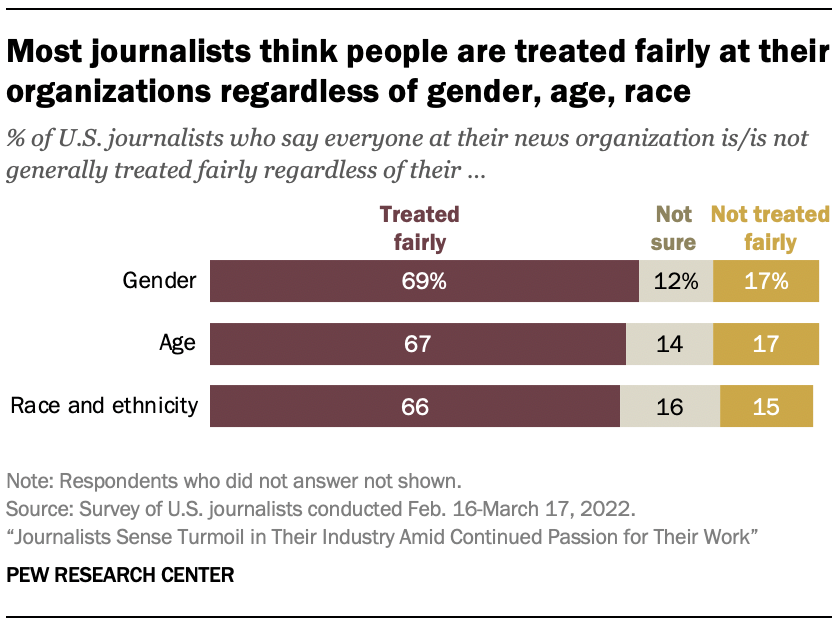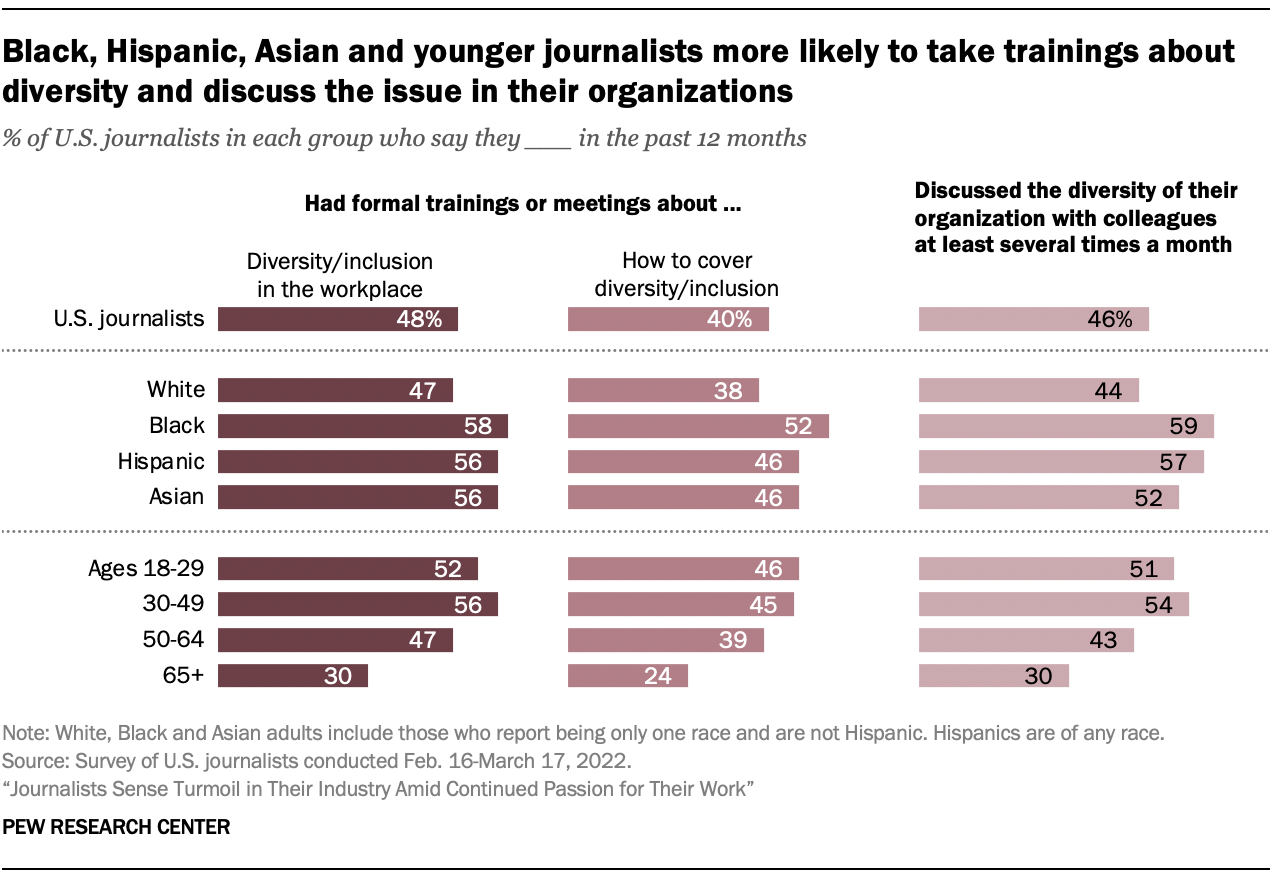The responses from the almost 12,000 journalists surveyed suggest that newsroom diversity is a work in progress: Journalists give their news organizations mixed grades on how well they are doing in building a sufficiently diverse staff. There is broader agreement that organizations generally treat staff fairly, regardless of age, gender, or race and ethnicity. Still, fewer than half of journalists say their organization makes issues of diversity and inclusion a major priority, and about half have participated in a formal training session about diversity in their workplace in the past year.
Along with the makeup of the newsroom itself, many experts say diversity can have a significant impact on the quality of journalism because a more diverse staff is likely to produce a wider range of stories and perspectives. As discussed in Chapter 4, fewer journalists say that news organizations do a good job at giving voice to the underrepresented than they do for a number of other core functions of journalism.

The survey asked journalists whether their news organization (or the main one they work for if they work for more than one) has enough employee diversity in several areas. Most say there is enough diversity in their newsrooms when it comes to gender and age. Two-thirds of journalists surveyed (67%) say their organization has enough gender diversity among its employees, compared with 19% who say it does not. And 58% say there is enough age diversity in their workplace, more than twice the share who say there is not (25%).
But journalists give lower marks for the levels of diversity in other areas. When it comes to diversifying the workplace by sexual orientation, 43% say their employers have enough employee diversity in this area, compared with 23% who say there is not enough and 31% who are not sure. About one-third say there is enough diversity when it comes to political ideology and socioeconomic status at their workplace (34% each). Another 34% and 29%, respectively, are unsure whether their organization has created sufficient diversity in each of these categories. This may speak to less transparency in those areas, or perhaps to uncertainty over how much diversity is “enough.”

Journalists give their news organizations the most negative ratings in the area of racial and ethnic diversity. By a considerable margin, more journalists say their organization does not have enough racial and ethnic diversity (52%) than say it does (32%).
Underneath the overall numbers are some clear differences in views across demographic groups – particularly age and gender. Younger and female journalists are often more likely than their older and male peers to think there is not enough diversity in their organizations. For example, 68% of journalists ages 18 to 29 say there is not enough racial and ethnic diversity at their organization, compared with 37% of journalists 65 and older. Those ages 30 to 49 and 50 to 64 fall somewhere in between at 57% and 48%, respectively. (See Chapter 7 for a deeper look at journalists’ views by age.)
On the same question about racial and ethnic diversity, a majority of journalists who are women (59%) say there is not sufficient diversity in their newsroom, compared with 46% of men.

Despite concerns about diversity at their organizations, about two-thirds of all journalists (66%) say their colleagues generally are treated fairly regardless of their race and ethnicity – similar to the shares who say staffers are treated fairly regardless of their age (67%) and gender (69%). In each case, between 15% and 17% say people are not treated fairly based on these factors, while the remainder are either not sure or decline to answer the question.

But again, there are differences on these questions based on the demographic characteristics of respondents. Asked about fair treatment of staffers inside the news organization, Black, Hispanic and Asian journalists are often less likely than White journalists to say that employees are treated fairly in all three areas — gender, age, and race and ethnicity – and in each case more likely to think that employees are not treated fairly. The same pattern applies to female journalists compared with male journalists, and for younger journalists compared with their older colleagues. (See Appendix for a detailed demographic profile of the journalists who completed the survey.)
For example, 53% of Black journalists and about the same portion of Asian journalists (55%), as well as 62% of Hispanic journalists, say that employees at their organizations are treated fairly regardless of their race and ethnicity, lower than the 69% of White journalists who say this. About a third of Black journalists (34%) say that everyone at their organization is not treated fairly regardless of their race and ethnicity, as do 29% of Asian journalists and 25% of Hispanic journalists – all higher than the 12% of White journalists who say the same.
Similarly, there is a 16-point gap between men (77%) and women (61%) in the share of journalists who say employees at their news organization are treated fairly regardless of their gender. On the other hand, 24% of female journalists say that employees at their organization are not treated fairly regardless of their gender, more than twice that of male journalists (10%).
About half of journalists took part in workplace diversity training in the past year; more likely among Black, Hispanic and Asian journalists
Fewer than half of the journalists surveyed say their organization places a great deal of focus on issues of diversity and inclusion at the workplace – 42% indicate it is a major priority for their organization. Another 30% characterize it as a minor priority, 16% say it is not a priority at all and 10% are unsure.
About half of all journalists (48%) say they have participated in formal trainings or meetings on diversity and inclusion in their workplace in the past 12 months – and four-in-ten have participated in sessions on how to cover these issues in the news. Perhaps not surprisingly, those who say their news organizations make diversity and inclusion a major priority are much more likely to have participated in these trainings. On a more informal level, 46% of the journalists surveyed say they discuss the topic of diversity with colleagues at least several times a month.

Black, Hispanic and Asian journalists are more likely than White journalists to say they engage in both training and informal discussions about issues of diversity and inclusion in their newsroom. Roughly six-in-ten Black (59%) and Hispanic (57%) journalists say they discussed diversity in their organization with colleagues at least several times a month in the past year, as do 52% of Asian journalists – compared with 44% of White journalists.
Large differences also emerge between age groups. For instance, 46% of journalists ages 18 to 29 as well as 45% of those 30 to 49 have had formal meetings or trainings about how to cover diversity and inclusion over the past 12 months, almost twice the rate of those 65 and older (24%).
Journalists who say their news organization has a left-leaning audience are more likely to engage with diversity issues, see diversity shortfalls
Journalists who say the audience of the organization they work for leans left politically are much more likely than those who say their audience leans right to engage with the issue of diversity at their organization, to say diversity and inclusion is a focus at their organization, and to see less diversity in some areas at their news organizations.
A majority of those who say they work for organizations with left-leaning audiences (56%) say issues surrounding diversity are a major priority, more than twice the share of those with right-leaning audiences (23%), and also higher than the share among journalists with more politically mixed audiences (42%).

Similarly, 56% of journalists who work for organizations with left-leaning audiences say they have had formal trainings or meetings on diversity in their workplace in the past 12 months, compared with 37% of journalists at outlets with right-leaning audiences and 49% of those with more mixed audiences who report these experiences. This pattern holds when it comes to having discussions with colleagues about their organization’s diversity.
Journalists who work for organizations with left-leaning audiences also are somewhat more likely to see their organizations as lacking in diversity in the areas of political ideology and socioeconomic status. For instance, 44% of journalists who work for organizations with left-leaning audiences say there is not enough political diversity in their newsroom, compared with 26% of those who say they work for organizations with right-leaning audiences and 22% of those with more politically mixed audiences.
Freelancers far less engaged with issues of diversity at news organizations

The 28% of journalists in the survey sample who identify as freelancers or are self-employed tend to be less engaged with issues of diversity and inclusion at the organizations that they work for. For example, one-in-five freelance or self-employed journalists say they had a formal training about how to cover issues of diversity and inclusion in the past year, substantially lower than the 47% of full- or part-time employees of news organizations. Freelance or self-employed journalists are also much more likely to be unsure of the level of diversity of the organizations they work for.




